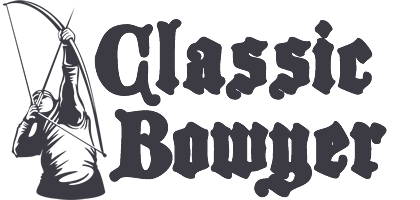My longbows are directly based directly on the ancient, medieval and Tudor weapons – to the best of our knowledge. However, the best of our knowledge is good and getting better all the time.
The longbow is deeply embedded in our history as a nation and a race. Many archers these days are turning to it and away from modern ‘plastic’ archery. Many take up archery with the express purpose of shooting in the longbow from the outset.
Not long ago, nearly all longbow archers shot in the style heavily influenced by the Victorian longbow tradition. Archery became a popular genteel activity in Victorian times and the bow was adapted accordingly. The design of the longbow evolved to a form that made it suitable for target shooting with light arrows at a straw target boss over a fine mown lawn. Modern target archery is largely descended from this. The design of the bow became actually more complicated with stiffened sections at the handle and tips. Nowadays, there is a new, exciting and vibrant current in longbow archery seeking to emulate the older great medieval and Tudor traditions both in the weapon itself and style in which it is shot.
The medieval longbow was not not radically different to the later Victorian version but it was simpler – and more mechanically efficient, though no less exacting in the precision required for its design and crafting. But what was it actually like?
As you can see from the images, medieval illustrations are very stylised and do not give a truly accurate idea of what bows were like in those days. They give some idea but appear almost like cartoons. The work of the 15th century artist Hieronymous Bosch who was a faithful and highly skilled draughtsman – one of the very few to accurately portray figures and objects as they really looked (albeit in highly surreal forms and situations!), occasionaly gives us a glimpse of the medieval longbow.
A demon-archer can be seen on the panel depicting hell from Bosch’s famous triptych ‘The Garden of Earthly Deights’ . He has shouldered, a convincing full-compass tillered longbow – bending through its entire length in the manner of the Mary Rose longbows.
Most of our knowledge today comes from the fantastic archaeological find of Henry VIII’s flagship, the Mary Rose which sank in the Solent in 1545. Over 100 well preserved Tudor longbows were recovered in the 1980’s from the anoxic mud in which they had lain entombed for around 450 years. They have been extensively examined and analysed by experts and have provided an invaluable insight into the longbow as a weapon of war. They have given us many answers, but also probably as many questions. You can see in the picture below that the bows are all very similar broadly in design but there is quite a variation in size. Indeed the largest look as if they could have been as much as twice as powerful as the smallest. The reason for this and subtle design differences between bows are not really understood at all.
The specimens are amazing and it is really compulsory for a true longbow enthusiast to take themselves down to Portsmouth and see them where some are exhibited. They look almost as if they had been made yesterday, the state of preservation being so good. It is true to say that they have given our understanding of the longbow a real quantum leap. These are Tudor bows and it is clear that even as late as the middle of the 16th century, the longbow was still a significant weapon of war. It is likely that by that time they were also a ‘mature’ technology, and had been for some time. Otzi, the famous ice-man found preserved in melt-waters from a glacier in the Austrian/Italian Alps who met his end around 3,300BC had among his belongings a yew longbow strikingly similar to the Mary Rose bows.
It is 600 – 700 years and about 30 generations back to the medieval Plantagenet era – the heyday of the longbow. In human terms, it is a long time ago. But it often does not seem very long ago in our collective memory. Echoes from that era resonate to this day and when re-created by skilled and knowledgeable re-enactors can seem strangely familiar and very close. However the social culture and mind-set were very different to today. Life was brutally pragmatic and death was never far away. All everyday objects made and used by medieval people were designed for ultimate practicality. A bow was an everyday object and all men from mid-teenage to the onset of old age were expected to be trained and proficient in its use for war.
The great warbows we have talked of were ever present, but there were also smaller bows – used for hunting in forests and even for vermin / varmint control. Bows and arrows would be used for the same uses in the countryside – where most people lived and worked in those days, as a shotgun, rifle or air-rifle today. A glimpse of such bows or their remains possibly survive to this day in the form of the enigmatic Hedgely Moor bow and Southampton bow. Smaller but nearly identical in design to their heavier brethren.
For centuries or indeed millenia, bows have been designed as purely practical devices with the intention of the bowyer to produce as efficient a weapon as possible from the material available – rather than to conform to a dictated style. This was true whether the bow in question was a warbow, a hunting bow or indeed a bow just for the express purpose of excellence in shooting.
I approach my bow-making in the same way. My longbows conform to the basic 5/8th rule of limb depth to width (allowing them to be used in the ‘longbow’ class at organised shoots), but apart from that my aim is maximum efficiency.
